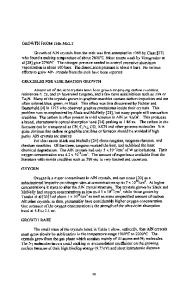Growth and Characterization of Ti 3 PSe 4 Single Crystals
- PDF / 3,115,877 Bytes
- 8 Pages / 417.6 x 639 pts Page_size
- 64 Downloads / 320 Views
GROWTH AND CHARACTERIZATION OF TlPSe 4 SINGLE CRYSTALS N. B. Singh, R. H. Hopkins, R. Mazelsky and M. Gottlieb Westinghouse R&D Center, 1310 Beulah Rd., Pittsburgh, PA
15235
ABSTRACT Good quality single crystals of Tl PSeA were grown from the melt by the Bridgman technique following improvements in the method of purifying the parent components, and optimization of growth parameters. Crack-free crystals 8 cm in length and 17 mm in diameter were produced. The quality of the crystals was evaluated by optical transmittance and metallographic techniques. In the range 0.7 to 14 #m the optical transmittance shows elimination of absorption bands exhibited in crystals grown without special purification steps. Etchpit studies showed that the crystals were free from inclusions and lamellar twins and that they show a uniform cross sectional etch pit density. INTRODUCTION Increasing demands for better infrared laser modulators, 1- switches, deflectors, signal processors and optical filters have driven research to improve the optical materials from which thesgdevices are made. Since the mid-nineteen seventies we have been exploring°-0 the growth and properties of ternary sulfosalt compounds and significant improvements have been made in their growth and device fabrication. Among the sulfosalts, T1 AsSe3 , TI VS , Ti AsS , and TI PS were the subjects of extensive studies which showel that these materials have very favorable 2 acogsto-optic properties. The acousto-optic figure of merit, V2 = l p /pv , is a measure of the inherent material diffraction efficiency independent of device geometry. This parameter was observed to be extremely high for sulfosalt materials. For example,
Figure 1 shows the variation in M with acoustic attenuation
for a number of important materials. Here we gave computed the figure of merit relative to quartz at X = 0.6328 /m the for photoelastic coefficient p.31. For devices where the diffraction efficiency is not important, other relevant figures of merit can be defined for such materials. Thallium phosphorous selenide is an orthorhombic material with acentric crystal structure. In earlier studies of T 3 PSe4 (TPS) crystal growth, TPS crystals exhibited inclusion formation, compositional inhomogeneity and a tendency to cleave preferentially along (010). In a continuation of our efforts to improve the optical quality of the chalcogenides, a systematic study was made of TI PSe synthesis and crystal growth. A significant improvement in the crystal size and quality was achieved, and the results are reported in the present article. 2.
EXPERIMENTAL PROCEDURE
2.1 Materials and Purification The TI, P, and Se used in the present study were identified by their manufacturers as SN purity material. Further purification of TI and Se was carried out to reduce the residual impurities. Reactant mixtures for crystal growth were prepared by weighing the starting materials in stoichiometric proportions of 3:1:4. The mixture was homogenized by raising
Mat. Res. SOc. SyMp. Proc. Vol. 90. '1987 Materals Research Society
Data Loading...











